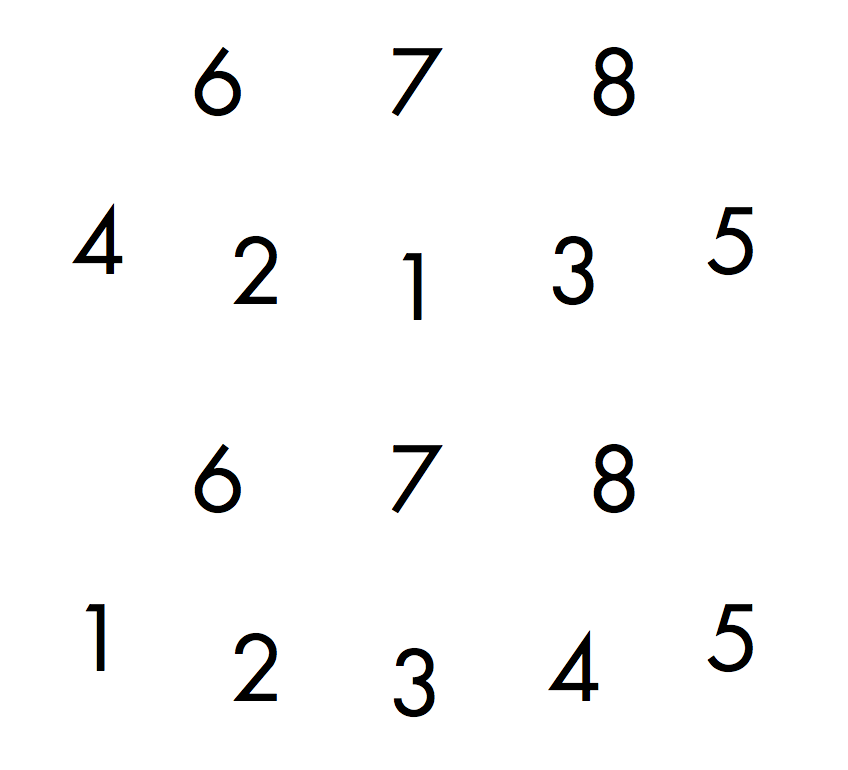Author: Joshua Benghiat

Savvy Position Label 4 User Guide
Savvy Position Label
version 4.5.0
User Guide
Created by Joshua Benghiat
Joshua Benghiat Lighting Design
Introduction
Requirements | Installation | Support
Getting Started
Adding to your Workspace | Registration | Overview
In Detail
– Placing in the Drawing
– Linking to a Position
– Object Parameters
– Known Issues
Frequently Asked Questions
Introduction
The Savvy Position Label is a plug-in object for labeling lighting positions and providing automatically updated notes about the position. The Savvy Position Label links to all Rigging Object types and as well as Truss Systems and Truss Lines and schematic views of those objects.
Savvy Configuration
Choose from numerous configuration options, allowing the Label to confirm to your personal drafting standard. The Savvy Position Label supports text styles and classes for granular control of its presentation.

Savvy Placement
The label is a separate object from the Lighting Position Object, so you can nudge or duplicate independently from the position. You can, optionally, have the label move with the position.
Savvy Label Text
Because you don’t always display the same position name on the plot that you use in the paperwork, the Savvy Position Label lets you display the first word, last word, just number, or custom text, with a prefix or suffix. Pipe A displays as A. #2 Electric becomes 2E, etc, while still automatically linking to the position name.
Savvy Note
An optional note lets you add tokens to automatically display US DS and SL SR coordinates, location, trim height, pipe length, and weight, which always stay up to date. You can also show summaries of attached objects to and component parts of the position.

Requirements
Vectorworks® Spotlight 2020 and above.
Installation
If you haven’t already, download the Savvy Position Label.
- The installer will have a .vwlibrary file extension for use with the Plug-in Manager. Do not manually install this file
- In Vectorworks, select Tools > Plug-ins > Plug-in Manager
- Select the Third-party plug-ins tab
- Click the Install… button
- Navigate to and select the saved installer file
- Read and confirm the EULA
- Vectorworks should notify you that installation is complete and to restart Vectorworks
If you experience trouble with the install script, please see the following FAQ on where plug-ins install. In the Plug-in Manager, you will see Savvy Position Label in the Built-in Plug-ins section.
Support
Please visit http://BenghiatLighting.com/software/support for support options and to report bugs.
You may also email software(at)BenghiatLighting.com.
Getting Started
Adding to your workspace
- Select Tools>Workspaces>Edit Current Workspace.
- Click the disclosure triangle next to JBLD in the list of Menus categories on the left hand side.
- Drag the Add Savvy Position Labels… and Update Position Label Notes menu command to the menu tree on the right side.
- Select the Tools tab.
- Click the disclosure triangle next to JBLD in the list of Tools categories on the left hand side.
- Drag Savvy Position Label to a tool palette on the right.
- Click OK.
Registration
The first time you use the Savvy Position Label, Vectorworks will ask you for a registration number or demo code. You can also access the registration dialog through the “About” button in the object’s Object Info palette. The Savvy Savvy Position Label will not draw without a valid code, however if you remove the Savvy Position Label plug-in from your user folder, you will still see all lineset objects but in a locked state. The Savvy Position Label is also part of the Savvy Subscription Series.
Overview
Insert the Savvy Position Label via the object tool or the included menu command. Labels can link to a Hanging Position for the label text and data displayed in the Label’s note, or you can enter custom text. A variety of display options are available in Object Info.
Placing in the drawing
The Savvy Position Label insertion tool
-
Select the Savvy Position Label insertion tool


- If you want to immediately link the label to a Hanging Position or set an unlinked position location, make sure the Link Button
 is enabled in the mode bar.
is enabled in the mode bar. - Optionally, select the Alignment parameter for the label in the mode bar. See Parameters.
- Optionally, set the insertion alignment of the label. The origin of the label is the first character for Left Alignment, last character for Right, and center for Center.
- Click in the drawing to insert the label and set the rotation.
- If you selected the Link mode, you will see a line connecting the label to a place-link cursor. Click on a Hanging Position to set the link. You will see the Position Object highlighted and the cursor change as you hover over it with your mouse.
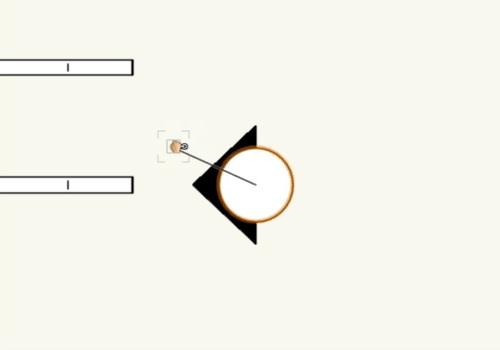
- If you do not select a position while in Link mode, the point on which you click determines the position’s location, which appears in the label’s note and to which the label’s leader line points. This can be useful when identifying a boom location in plan view, for example.
The Add Savvy Position Labels menu command
- Select Hanging Positions to which you want to add labels.
- Select the Add Savvy Position Labels… menu command.
- Select options in the dialog:
The position option sets the position of the label around the Hanging Position, as well as Alignment and Arrow Angle parameters so that the arrow points towards the Position.
The offset specifies the distance from the edge of the position to the insertion point of the label. A positive value measures away from the position in any direction.
Show options will raise the Label’s default parameters dialog before placing labels.
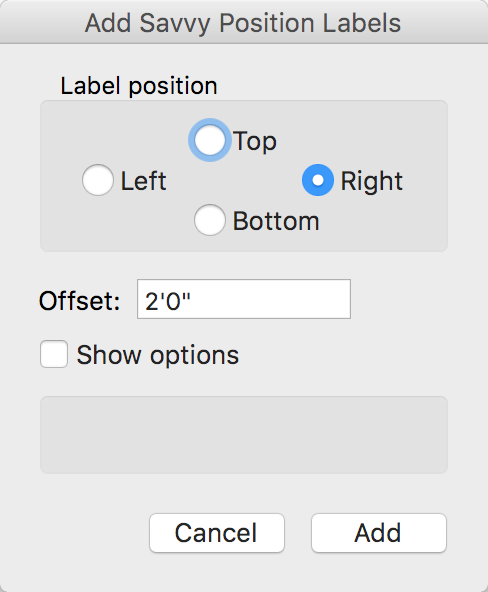
Linking to a Position
Linking Labels to Positions synchronizes the Label with the Position name and moves the label when you move or duplicate the position. Linked labels can also automatically display various data about the position and attached items in the Label’s note.
Inserting Position Labels using the above methods link the Label to a Position.
Linking Existing Labels to Positions
To associate an existing Label with a Position, you can use the control point grip in the drawing to the Link to Position dialog.
Using Drawing Grips
Savvy Position Label indicates the link to the position with a chain link icon. When you hover over this icon, the cursor changes to a hand. You can click to pick up the link and drop it on another position.

Using the Link to Position Dialog
Cclick the Set Link button in Object Info, or right-click on the label and choose Set Link…
In the resulting dialog, select from a list of positions in the drawing, identified by name, or choose Click on drawing to select to exit the dialog and use your cursor to select a Hanging Position in the drawing.
Unlinking a Label from a Position
To unlink a label from a position, use this dialog, or right-click on a label and select Unlink.
Linking to Truss Systems and Lines
When linking to a Truss object, you can link the label to a single truss piece, or the entire Truss System or Truss Line. This affects both the label displayed and the data displayed in the note.
In the Label section of Object Info, select Truss Piece, Truss System, and Truss Line. If the Label is linked to an object other than Truss, this option has no effect.

Linking to Rigging Objects in Viewports
Savvy Position Label objects can link to objects inside viewports, including section viewports, updating data and tracking the location of the position. Due to a limitation in Vectorworks, you can only set the link to the position via the list in the Link to Position menu.
Object Parameters
As with all Plug-In Objects, the first time you place a Savvy Position Label object in a document, Vectorworks will ask you for default parameters. You can set the default object parameters for the document by selecting the object’s tool, then clicking on the parameters button  in the mode bar.
in the mode bar.

| Parameter | Description |
| Text Style | Pick a text style for the label. To set a default text style, use class options to set the text style by class. |
| Style | Use this menu to apply, create, or modify a Style definition for the label. Label styles appear as “red” symbols in the Resource Manager, and specifies whether parameters reference the style definition. For more information, see Concept: Plug-in Object Styles in Vectorworks help. |
| Hide Style Parameters | Enable this option to hide any parameters linked to a style definition. |
| Linked to |
Read only field displaying the name of the position to which the label is linked. When you select a Position Label, you will also see a link icon in the drawing indicating the link. |
| Set Link |
Raises a dialog where you can select a Hanging Position to link to the label. You can also opt to click on a position object or unlink the label from a position. 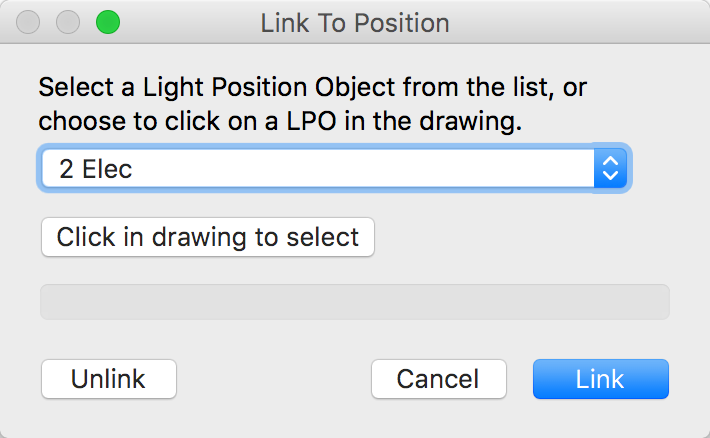 |
| Edit Position Name | Use this button to edit the name of the position. If the Label links to a Truss System, you can use this to edit the name of the System. |
| Alignment | Left / Center / Right: Determines the text alignment and arrow position for the label.  |
| Move with position | Enable this to move the label as you move the position, as though they are grouped. Moving the label, however, does not move the position. |
| 3D Rotation | Enter a value for rotating the 3D component of the label around its horizontal axis. |
| 3D Only | By default, the Savvy Position Label is hybrid, with the label appearing both in plan view and at the z height of the position. The 3D component of the symbol can only rotate along its horizontal axis, so a typical label would then face forwards with a 90 degree 3D Rotation. Setting the label to 3D only allows the planar label to rotate to any 3D plane. In this mode, you do not see a 2D version of the label in Top / Plan. |
| Label | |
| Label Display | Determines how the position name displays in the label. Full: The full name. First word: The first word, before a space. E.g. “1 Electric” would be “1.” Last word: The last word, after a space. E.g. “A Pipe” would be “A.” Only Number: Extracts a number from the name. e.g. #4 Elec would be “4.” Custom: Ignores the position name and uses the text field below. If you do not link a label to a position, the object sets this option as default. |
| Cust. Label | Use with the Custom label display option to completely override the position’s name. |
| Prefix | Adds a prefix before the label text. |
| Suffix | Adds a suffix after the label text. |
| Truss Identity | When the Label is linked to a Truss object, you can link to a single truss piece, a truss line, or the entire truss system. This option affects both the Label text as well as any data in the Note. |
| Shape | |
| Container | Circle / Rectangle / Rounded rectangle / Diamond / None: Choose a container for surrounding the label. The circle and diamond containers will surround the first or last character in left or right modes.  |
| AutoFit | Fit the container to the label text. |
| Width | If AutoFit is disabled, specify the size of the container, in page units. |
| Padding | Add an additional amount of white space between the text and container, in page units. |
| Draw shadow |
Add a drop shadow to the container. 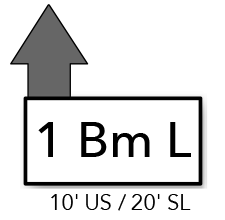 |
| Use Class Options | Use the shadow options assigned to the class for the container. |
| Shadow Settings… | Set the shadow options for the Container drop shadow. This uses the same interface as in the Attributes palette. |
| Arrow type | Triangle / Arrow / None / Symbol: Choose an arrow that points from the label to the position. You can also select no arrow and a custom symbol for the arrow.  |
| Symbol | If you select the Symbol option above, specify the symbol here. This is a text field for ease of copy and paste. Use the button below to select a symbol resource. |
| Select symbol | Select from available symbols. |
| Arrow Angle | 90 / 0 / –90 / Custom: Sets the arrow straight, up, or down, depending on orientation. Select Custom to set an angle via the field below.  |
| Cust. Angle | Enter a custom arrow if chosen above. |
| Arrow scale | Scale the arrow to refine the look of the label. A scale of 1 equals 100%.  |
| Mirror Arrow | Enable this option to display an arrow on both sides of the label.  |
| Note | |
| Show note | Enable this to show a note below the label. |
| Text Style | Optionally, set a separate text style for the note. |
| Alignment | Choose to align the note consistently with the label or specify its own Left, Center, or Right alignment.  |
| Wrap note | Enable this to wrap the note to the length of the container. |
| Fit container to note |
With this option enabled, the container grows to include the note text. 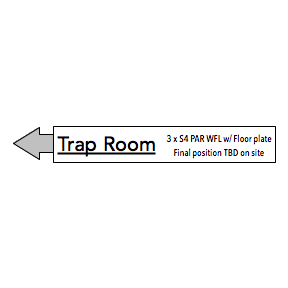 |
| Note | The note text. This field is for easy access and copy / paste. |
| Edit note | Presents a dialog for editing the note. The note can be multiple lines and can insert tokens that will update with data about the position and attached items. After selecting one of the options in the lower section of the dialog, click Insert to insert placeholder text at the cursor point. Special Fields:X Measurement, Y Measurement, and L/R Measurement take their data from the Label’s Position control point, which defaults to the Hanging Position’s insertion point. Move the control point or set the data fields below to specify any point in the drawing. SL/SR Indicator will display “SL” or “SR” depending on which side of x=0 the location control point lies. Location takes its data from the Position’s Location field, which can store a lineset number or other location data. Pipe Length gets its data from the length of Lighting Pipe, Straight Truss, or Line geometry used for the Hanging Position. Trim gets its data from the Hanging Position’s z height. A setting can specify an offset for the display trim if trims are not measured to the stage floor. Weight calculates the total hung weight of the Rigging Object and any attached items. Truss Height/Width will display the dimensions of the cross section of truss. DMX Footprint will total the number of DMX addresses needed for a position. This will only include Moving Lights, Accessories, Devices, and SFX. Summary of attached items or component parts:Use these options to include a summary of objects attached to the position (Lighting Devices, Speakers, Softgoods, etc.) or component parts of a Truss System, Truss Line, or Hanging Position. Count – Totals the unique types of data for the specified parameter of the specified object. Set the parameter to to count objects of that type. For example, Count of Lighting Device Channel will tell you how many unique channels are in that position. Count of Truss will give you the total number of truss sticks in a system. Sum – Totals numerical data in the specified parameter for attached objects. For example, Sum of Soft Goods AdjustableLength will calculate the total linear feet of drape attached to the position. Max / Min – Displays the largest or smallest value of the chosen parameter. For example, Min/Max of Lighting Device Circuit Name will tell, respectively, you the first and last circuit names in that position when sorted alphabetically. List – Lists all the values for the selected field and the total quantity for each value. For example, List of Lighting Device Instrument Type will display the quantity of each instrument type used in the position. Rigging Object Field:Displays any parameter for the attached Rigging Object or data field of a record attached to the rigging object.  |
| Rounding | Round the coordinate data by this value. |
| Adtl. Trim Offset | Enter a value to offset the reported trim from the position’s z height. Useful for trimming above rakes and platforms. |
| Auto position note | Enable this to automatically position the note below the label. |
| Leader Line | |
| Position X, Y |
The coordinate of the position that displays in the note. This also corresponds to a control point in the drawing. If the label is linked to a position and set to move with the position, this coordinate will adjust as you move the position. |
| Reset Leader | Resets the Position X / Y coordinates to the insertion point of the position. |
| Flip Leader | Reflects the Position X / Y coordinates across the midpoint of the position. |
| Draw leader to position | Draws a leader line from the label to the position coordinate. |
| Leader type | Straight / Bezier / Shoulder: Choose the type of leader line.  |
| Draw symbol at endpoint | Add a symbol to mark the position location, for example a boom marker or rigging point.  |
| Symbol Name | The name of the symbol. This field is provided for ease of copy / paste. |
| Symbol Rot | Rotation of the position marker symbol. |
| Select symbol | Choose an available symbol resource for the position marker. |
| Classes | |
| Auto-Class | Enable this to class each component with default class names. The prefix for subclasses can be determined in settings. |
| Container Class | Class for the container geometry. |
| Arrow Class | Class for the arrow. If no by-class options exist for the arrow, it will fill solid black. |
| Shadow Class | Class for the container drop shadow. |
| Leader Class | Class for the leader line. |
| Note Class | Class for the note text. |
| Update | Any changes to the Hanging Position that affect the Savvy Position Label text, placement, or note should automatically update the Label, but this button will force an update to catch any unreflected changes. |
| Settings… |
Set settings that affect all Savvy Position Label Objects Default insertion class: Choose a class for new Label objects. You can also opt to insert labels in the active class. Component class prefix: Enter a base class name that the Auto-Class option will use to build class names. Trim offset: Enter an offset for the trim display, for example to display trims above a show deck height, with this value subtracted the Hanging Position’s Z height. Note, the trim starts at the layer’s elevation. Make default for all new documents: Select this option for these settings to be default values for all future new Vectorworks documents. |
| About | See version and registration information |
Savvy Sequencer 2 User Guide
Savvy Sequencer
version 2.0.0
Users Guide
Created by Joshua Benghiat
Joshua Benghiat Lighting Design
Introduction
Requirements | Installation | Support
Getting Started
Adding to your Workspace | Registration | Overview
In Detail
Savvy Sequencer dialog
Introduction
Requirements
Vectorworks 2012 or higher
Installation
If you haven’t already, download the Savvy Sequencer Installer from the JBLD downloads page . There are links to download for 2012/2013 or 2014/2015.
For installation to Vectorworks 2012 or 2013:
Make sure Vectorworks is not running. Run the Savvy Sequencer Installer. Select your version of Vectorworks. The installer will install a folder called “-JBLD Savvy Sequencer” in your user Plug-Ins folder, containing the Savvy Sequencer menu command.
The Windows installer allows you to select a custom location for your Plug-Ins folder. Mac users with a custom user data location or Windows users having trouble with the installer can download the “Raw installer” and manually drag the “-JBLD Position Pipes” folder to Plug-Ins. For more information, see this FAQ .
For installation to Vectorworks 2014 or 2015:
- The installer package must remain a zip file. If your system automatically unzips archives, right-click on the download link and select “Save Link As” to prevent your browser from auto-expanding the download.
- In Vectorworks, select Tools > Plug-ins > Plug-in Manager
- Select the Third-party plug-ins page
- Click the Install… button
- Navigate to and select the saved installer zip file
- Read and confirm the EULA
- Vectorworks should notify you that installation is complete and to restart Vectorworks
If you experience trouble with the install script, please see the following FAQ on where plug-ins install .
Support
Please visit http://BenghiatLighting.com/software/support for support options and to report bugs.
You may also email software(at)BenghiatLighting.com.
Getting Started
To use the Savvy Sequencer command, you must add it to your Workspace.
Adding to your Workspace
To add Savvy Sequencer to an existing workspace:
- Select Tools>Workspaces>Workspace Editor or Edit Current Workspace… .
- In the Menus tab, click the disclosure triangle next to JBLD in the list of Menu categories on the left hand side.
- Drag Savvy Sequencer to an existing menu on the right, for example, Tools.
- Click OK .
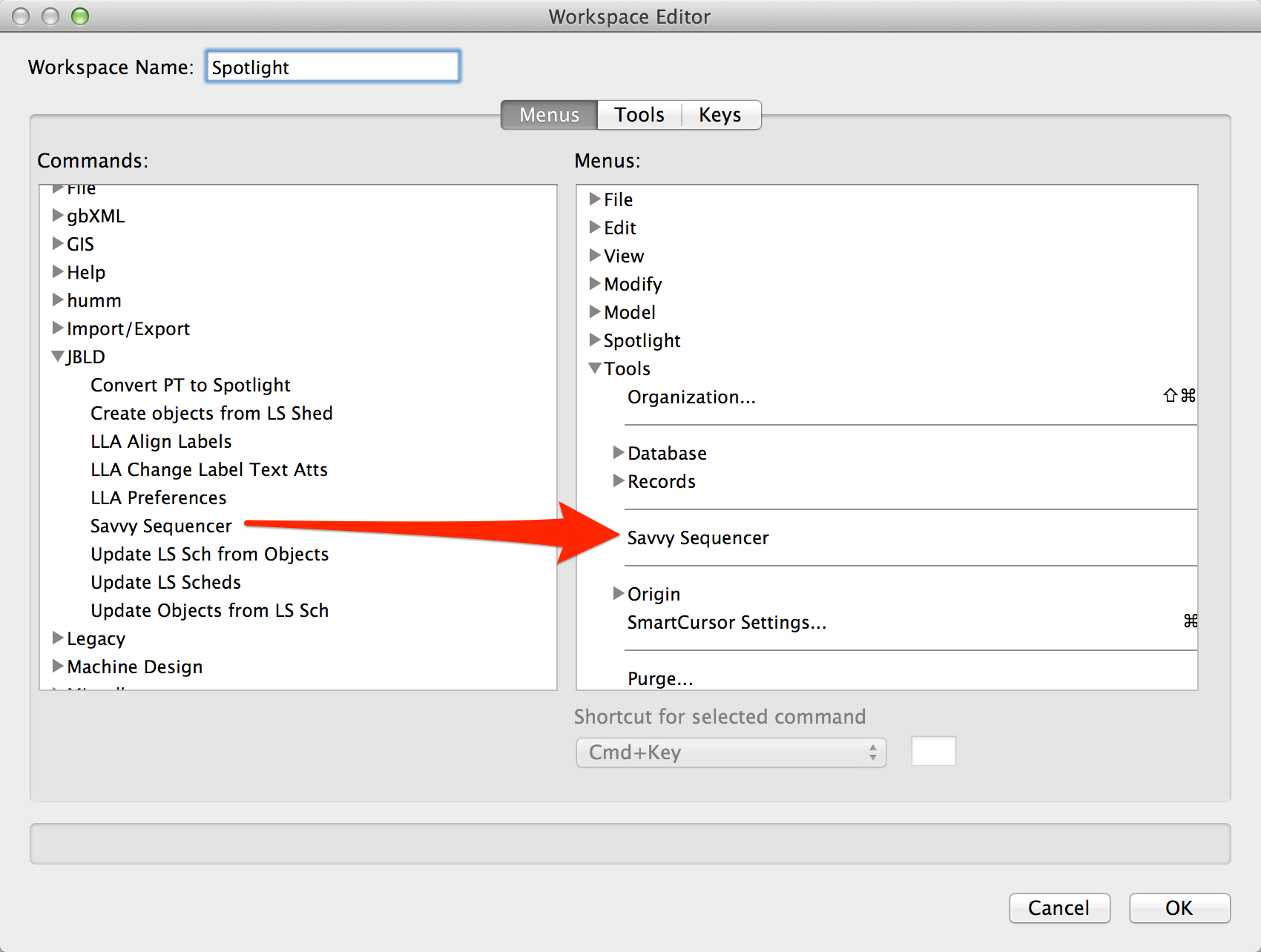
Registration
The first time you use Savvy Position Sequencer, you will be asked for a registration number or demo code. You can also access the registration dialog through the ” About ” button at the bottom-left of the Sequencer Dialog.
Overview
The Savvy Sequencer will add sequential text labels or data entries to selected objects, based on their screen arrangement. The Sequencer will work with existing text objects or create new ones, look inside groups for text, and apply date to either attached record or plug-in parameter fields. Sequences can be numeric or alphabetic, start at any point, have any increment, and include leading or trailing text. The sort order can be as a linear or rectangular array or traverse objects in a circle.
For a list of key features and screenshots, visit the Savvy Sequencer product page .
In Detail
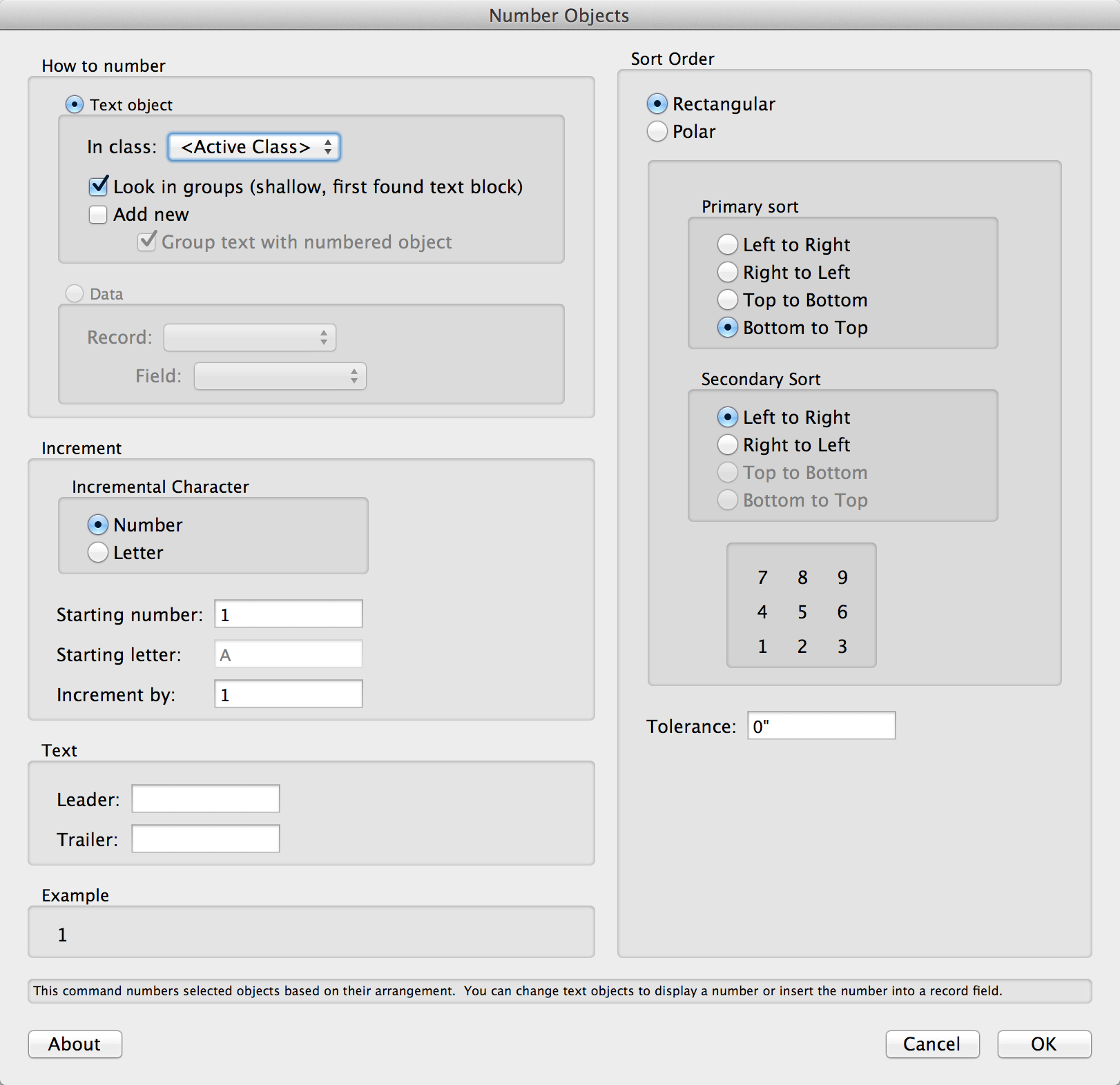
Dialog Options
| Option | Description |
| How to number
First, determine how you want to sequence the selected objects. You can label objects with text or enter data in record fields or plug-in parameters. |
|
| Text object | Choose this option sequence with text labels. Choose this option to use existing text objects, to add new text selected objects, or to search for text within a group. |
| In class: | Select a class to only number text of a certiain class. This can be useful to number specific text blocks within a group. This will also be the class for new text objects. You can also choose Any Class or to use the Active Class. |
| Look in groups (shallow, first found text block) | Select this option to look for text objects within groups. The command will only number the first found text object in each geoup of the selected class. |
| Add new | Select this option to add text to other types objects. If a text object in the specified class is already found, the Sequencer will not create a new object. |
| Group text with numbered object | Select this option to create a group containing the object to number and the text object. |
| Data | Choose this option to insert the sequence text into a field or parameter. |
| Record: | Choose a record. |
| Field: | Choose a field in which to insert the sequence text. |
| Increment
Choose options for how the sequence should increment. |
|
| Incremental Character | Choose to sequence by letter or number. |
| Number | Sequence with numerals. |
| Letter | Sequence with letters. |
| Starting number: | The number of the first item. |
| Starting letter: | The letter of the first item. |
| Increment by: | The counter will incement by this number. |
| Text
Choose additional text to prepend or append to the counter. |
|
| Leader: | Text to prepend to the counter. |
| Trailer: | Text to append to the counter. |
| Example | An example of your formatted label. |
| Sort Order
Choose how to sort the selected objects. |
|
| Type | Choose how to sort the selected objects. |
| Rectangular
Sort objects in a rectangular (or linnear) array. You can specify a primary sort and a secondary sort. |
|
| Rectangular sort options | |
| Primary sort | Choose a primary sort direction. See the array below as an aid. |
| Secondary Sort | Choose a secondary sort direction. See the array below as an aid. |
| Tolerance: | Specify how closely two objects’ coordinates can be for the sequencer to consider them aligned.
The following example has a primary sort of bottom to top and a secondary sort of left to right. The top example had a tolerance of 0, while the bottom example uses a tolerance for the bottom row of numbers to be sequenced together.
|
| Polar
Sort objects in a circle. |
|
| Polar sort options | |
| Direction: | Choose to sort objects in a clockwise or counterclockwise direction. |
| Clockwise / Counterclockwise | Choose to sort objects in a clockwise or counterclockwise direction. |
| Center x and Y: | Specify the coordinates for the center about which to sort. |
| Begin From: | Specify the origin of ther sort in degrees. 0° is to the right, or 3:00. |
| Next Mouse Clicks | Choose the Polor Sort’s center and start by clicking in the drawing after exitig the dialog. |
